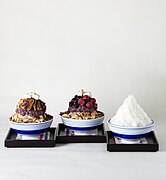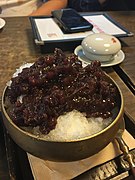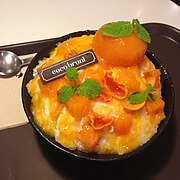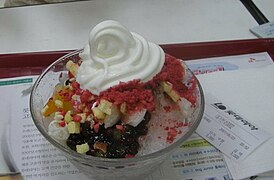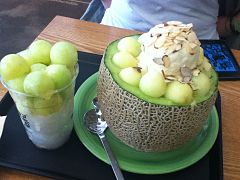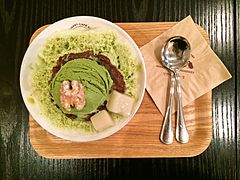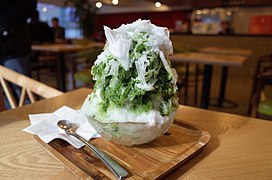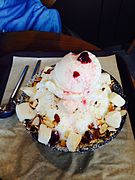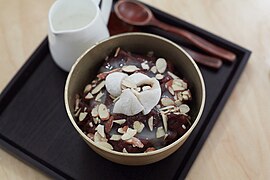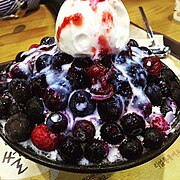Bingsu
 | |
| Alternative names | bingsu, bingsoo |
|---|---|
| Type | Shaved ice |
| Course | Dessert |
| Place of origin | Korea |
| Serving temperature | Cold |
| Main ingredients | Shaved ice, red beans |
| Variations | Nokcha-bingsu (green tea bingsu), ttalgi-bingsu (strawberry bingsu), choko-bingsu (chocolate bingsu), etc. |
| Korean name | |
| Hangul | 팥빙수 / 빙수 |
|---|---|
| Hanja | -氷水 / 氷水 |
| Revised Romanization | pat-bingsu / bingsu |
| McCune–Reischauer | p'at-pingsu / pingsu |
| IPA | [pʰat̚.p͈iŋ.su] / [piŋ.su] |
Patbingsu (팥빙수, -氷水, sometimes anglicized as patbingsoo, literally "red beans shaved ice") is a popular Korean shaved ice dessert with sweet toppings that may include chopped fruit, condensed milk, fruit syrup, and red beans.[1] Varieties with ingredients other than red beans are called bingsu[2] (or bingsoo).[3]
The food originally began as ice shavings with red beans (known as pat, 팥). Many varieties of patbingsu exist in contemporary culture.
History
The early forms of patbingsu consisted of shaved ice and two or three ingredients, typically red bean paste, tteok, and ground nut powder.[4] The earliest forms of patbingsu existed during the Joseon dynasty (1392–1897). Government records show officials sharing crushed ice topped with various fruits.[5][6]
The modern version of the dessert usually is placed in the Korean bakery Tae Keuk Dang. However, elder people in Korea use to point out that the patbingsu became popular after the Korean war. The dish was made with ingredients from the USA surplus supplies and was sold as street food.[7]
Variations
There are a variety of patbingsu types and flavors. Many bingsu do not necessarily follow tradition, and some do not include the red bean paste.[8] Some popular flavors are: green tea, coffee, and yogurt.[9]
Availability
Patbingsu can be found at most fast food restaurants, cafes, and bakeries in South Korea.[1] Patbingsu is also a very popular dessert at cafes in Koreatowns around the world.[citation needed]
Gallery
-
Various bingsu
-
Patbingsu
-
Persimmon bingsu from Coco Bruni patisserie in Hannam-dong, Seoul
-
Lotteria offers an elaborate version with ice cream
-
A yogurt bingsu from the popular Korean Red Mango chain
-
Melon bingsu from 'Chaoruem' near Gangnam station.
-
Patbingsu topped with fruits
-
Berry bingsu
-
Milk tea bingsu
-
Black sesame bingsu
-
Green tea bingsu
-
Green tea bingsu
-
Cheese bingsu
-
Patbingsu
-
Mixed-berry bingsu
See also
References
- ^ a b Lee, Robyn (June 5, 2009). "Snapshots from South Korea: Patbingsu, a Popular Shaved Ice Dessert". Serious Eats. Retrieved January 5, 2013.
- ^ Kyoung Woo Jun, for. "Seoul hotels at war over dessert - CNN.com". CNN. Retrieved May 5, 2016.
- ^ Hoo, Winyan Soo (July 16, 2014). "Plate Lab: A guide to Asian shaved ice desserts halo-halo, bao-bing and bingsoo". The Washington Post. ISSN 0190-8286. Retrieved May 5, 2016.
- ^ Min, Ines (June 3, 2010). "Ice cream explorations and a peek into the past". The Korea Times. Retrieved January 5, 2014.
- ^ Dang, Tae Keuk (September 13, 2010). "Snowy delights and variations on bingsu". Herald Corporation. Retrieved January 6, 2014.
- ^ 팥빙수[氷水] [Patbingsu]. Doopedia (in Korean). Doosan Corporation. Retrieved January 6, 2014.
- ^ "Seoul Eats: The Origin of Patbingsu". Seoul Eats. Retrieved August 9, 2020.
- ^ "Bingsu, an unbeatable summer treat!". KOREA TOURISM ORGANIZATION. Retrieved January 6, 2014.
- ^ Lee, Ji-yoon (July 7, 2008). "Korea's cold summer taste - naengmyeon and patbingsu". Korea.net. The Korean Culture and Information Service. Retrieved January 6, 2013.

